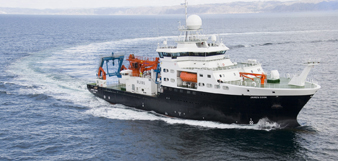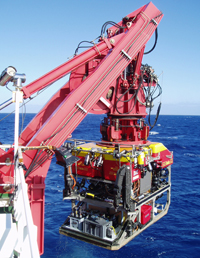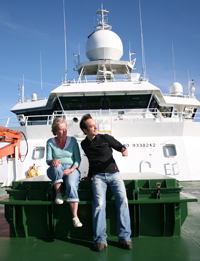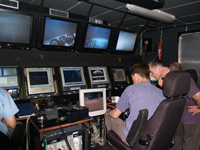Classroom@Sea: bringing real marine science into the classroom Teach article
Bringing marine science into the classroom can be challenging work for teachers. So why not take the classroom – and the teachers – to sea? Vikki Gunn’s Classroom@Sea project does just that.
With our oceans coming under increasing pressure from human activities, there has never been a more urgent need to understand the marine environment and how it works. This applies not only to scientists and policy makers, but also to the general public and, perhaps most importantly, to the marine scientists of the future – school children. Classroom@Sea is a novel outreach initiative designed to bring cutting-edge marine science into classrooms across Europe. Based around real scientific expeditions on research ships, Classroom@Sea engages teachers and pupils in the journey from scientific hypothesis to investigation, discovery, analysis and interpretation.

which was home to six teachers during a research
cruise in Summer 2007
Image courtesy of NOCS / HERMES
In UK schools, as in those of many other European countries, marine and earth sciences are taught only at a very basic level, if at all. Although this is improving, the few marine or earth science concepts that exist in the curriculum are often taught in a very ‘dry’ fashion with few visual or practical aids to bring the subject to life.
With global change now a high priority in European research, it is essential that school children and the general public are not only aware of the issues threatening our oceans today, but also engaged in the research so that they understand the processes by which scientists obtain their results. This is particularly important now, when so many important policy decisions are being taken that will affect their future enjoyment and use of our oceans.
Understanding how our oceans work is fundamental to ensuring that future generations have the tools to manage, conserve and enjoy the oceans responsibly.

operated vehicle (ROV) Isis from
RRS James Cook to survey the
mud volcanoes in the Gulf of Cadiz
Image courtesy of NOCS / HERMES
As marine scientists, the most fundamental activities we undertake are expeditions to remote areas to probe the ocean’s secrets, using dedicated research vessels equipped with the latest technology. For most members of the general public, the notion of boarding a ship to undertake a scientific mission in one of the most inaccessible and hostile environments on the planet – the deep sea – is the stuff of science fiction rather than science fact. Classroom@Sea invites the non-scientist to join the expedition and share in the experience, not only from a scientific perspective but also in terms of living life in the alien environment of a research vessel. It is these expeditions that provide the greatest opportunity to stimulate young minds and encourage young people to consider a career in marine science.
The Classroom@Sea initiative is led and managed by the National Oceanography Centre, Southampton (NOCS), UK.
From its conception in 2003, the project’s aim has always been to enthuse and inspire school children by sharing the journey of scientific exploration and discovery. And what better way to do this than by recruiting schoolteachers to join the scientific team on board the ship? There are many scientists who are excellent at communicating their research to the wider public. However, teachers are ideally qualified and placed not only to share the excitement of being at sea on a scientific expedition, but also to communicate the ideas, concepts and theories in a format appropriate to our target audience: school pupils. Teachers’ understanding of the curriculum means that they are able to apply their experiences on board the ship to aspects of their teaching where they would otherwise rely on standard demonstrations or examples. Many of the basic scientific principles taught to 11- to 16-year-olds can be demonstrated using the marine realm as an example; indeed, finding new and innovative ways to present concepts and theories provides an invigorating and rewarding experience for teachers and pupils alike. Life on a research ship is a unique experience and, we feel, best communicated to the outside world through the eyes of someone who is experiencing it for the first time.

(Barcelona, Spain) and Gillian
McGahan (Berkshire, UK) enjoy
a break from the heavy work
schedule on board RRS James
Cook
Image courtesy of NOCS / HERMES
In the summer of 2007, Classroom@Sea recruited six schoolteachers from the UK, Spain and Portugal to participate in a major multidisciplinary cruise aboard the UK’s newest research vessel, the RRS James Cook. Equipped with the remotely operated vehicle (ROV) Isis and carrying aninternational team of marine geologists, biologists, geochemists, geophysicists, ecologists and oceanographers, the cruise set out to investigate the exotic mud volcanoes in the Gulf of Cadiz, the vast submarine canyons off the shores of Portugal, and the mysterious Whittard Canyon off the shores of Ireland. As such, the cruise was divided into three legs of two to three weeks’ duration, with two teachers on board for each leg.
In the run-up to the cruise, the teachers documented their preparations for sea-going, including the indignity of hauling themselves into a life-raft during the compulsory sea survival course! They also researched material to add to the ever-growing archive of background science information available on the Classroom@Sea websitew1, and designed simple experiments with their students to carry out on board.
Once at sea, the teachers composed daily ‘blogs’ of their experiences for the Classroom@Sea website, relating tales of the trials and tribulations, anticipation, successes and occasional disappointments that are an integral part of a scientific expedition. Online feature articles on the roles of crew members and the scientific team, and how the ship’s cook caters for the masses without a supermarket nearby, a video tour of the ship and ROV video footage of a shipwreck served to draw in even the most non-scientifically minded pupil in the audience.
Those following the progress of the cruise on the website were able to communicate with the team on board via an interactive question and answer session, in which the team were tested by a range of questions varying from the predictable “How deep is the sea where you are?” to the more taxing “Do fish break wind?”, which sparked a lengthy debate amongst the marine biologists on board!
As well as providing the obvious benefits to teachers and schools, the involvement of teachers on a cruise is also a positive experience for the scientists on board.

van – the hub of activity during
an ROV dive. Live feed from the
ROV cameras can be seen on the
upper monitors
Image courtesy of NOCS / HERMES
When faced with the need to explain their research at its most basic level, scientists must often view problems from new and unexpected angles. Teacher Gillian McGahan, who participated in the first leg of the cruise (the Gulf of Cadiz, 14 May – 2 June 2007), says, “As a teacher it is probably the best professional development I could have had. This experience has made me think of new ways to approach the curriculum. I have been given so much interesting support material and made aware of many resources that have been developed to enable us to teach science through oceanography, and I hope to be able to encourage colleagues to use this to develop their teaching as well. I feel that I now have a much better and deeper understanding of biodiversity along the European margin and I am really looking forward to sharing this with my pupils.”
Fellow teacher Eduard Vives Mayol agrees: “Classroom@Sea has been one of the best educational experiences I have had. I have learned more than I could possibly imagine during the cruise. Working on the project and sharing ideas with scientists has been a hugely positive experience, particularly devising ways in which to share our experiences over the Internet. The atmosphere and the excitement on board the ship have increased my enthusiasm for teaching science.”
Unfortunately, funding is not always available to finance the participation of teachers in NOCS’s expeditions, but if there are no teachers taking part, a small team of shipboard correspondents are recruited from the onboard scientific team. For the most part, these individuals tend to be PhD students or young researchers, many of whom are going to sea for the first time. With communication skills becoming an increasingly valuable and essential asset, the exercise greatly benefits the researchers as well as the audience.
Share the excitement of scientific discovery onlinew1.
Joining the team
When funding is available to include teachers on the cruises, the places are advertised on the Classroom@Sea websitew1.
Web References
- w1 – The Classroom@Sea website includes many resources for teachers, such as activities for teaching biology, chemistry, physics and geology/geography. To learn how to demonstrate osmoregulation with a piece of potato or to show how submarines work using lemon peel, see: www.classroomatsea.net
- Other useful resources on the website include posters to download, questions from children (and answers), a daily diary written by the teachers involved and plenty more information about oceanography.
Resources
- Other schools resources from NOCS include:
- Ocean Zone magazine: www.noc.soton.ac.uk/nocs/ocean.php





